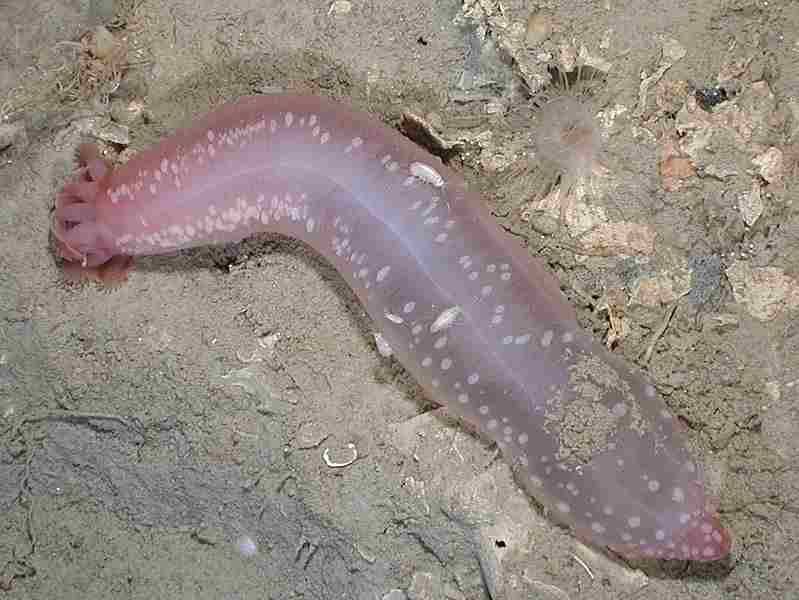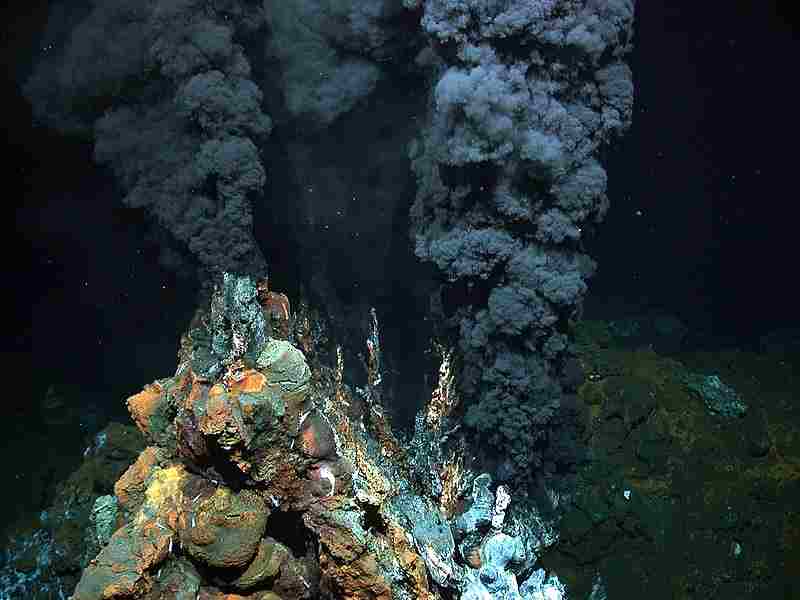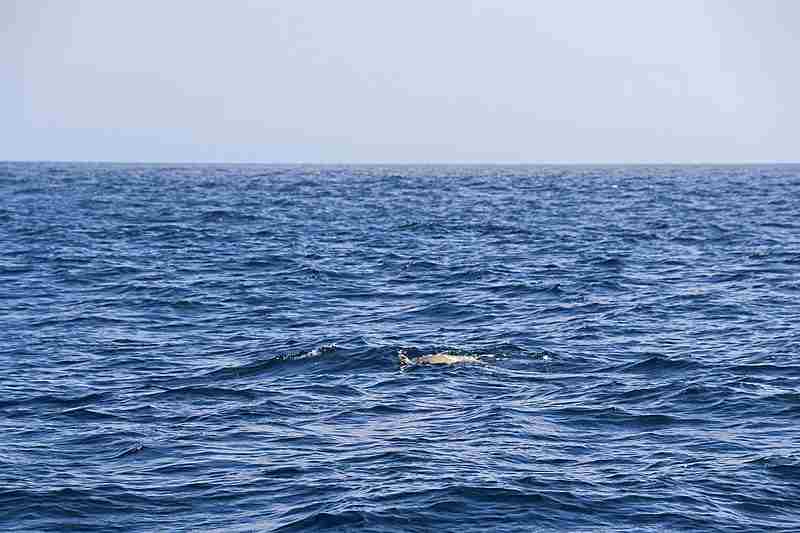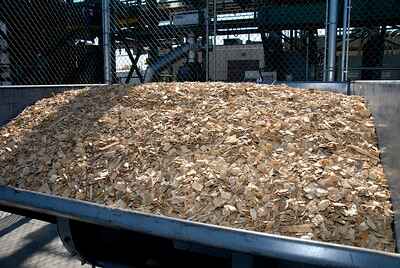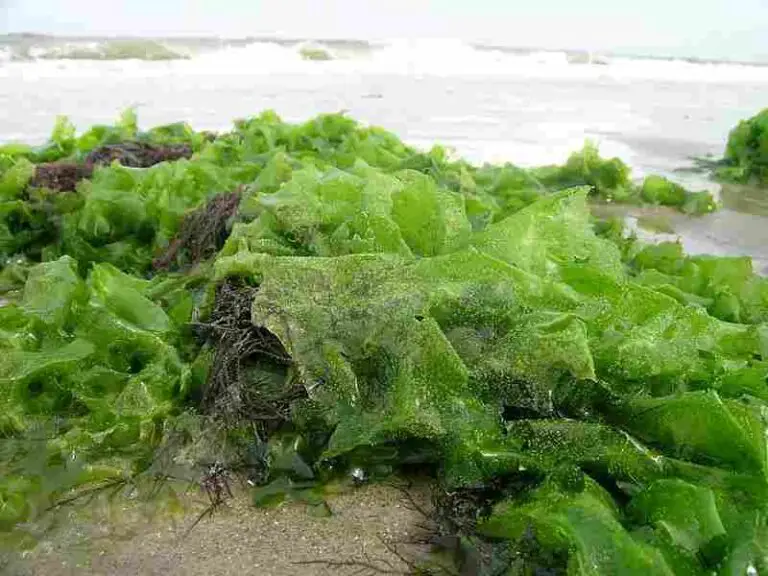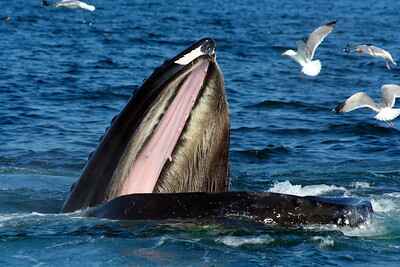7 Abiotic Factors in the Abyssal Zone and Their Characteristics, Functions
Abiotic factors in the abyssal zone are; water, nutrients, rocks, sediments, physicochemical parameters, circulating currents, and topographic features.
This article discusses abiotic factors in the abyssal zone in terms of their characteristics and functions, as follows;
1). Water: One of the Abiotic Factors in the Abyssal Zone
Abyssal water refers to the water that is found in the abyssal zone of the ocean, which is the section of the ocean that lies deeper than about 2,000 meters (approximately 6,600 feet) [4]. This zone is characterized by high pressures, near-freezing temperatures, and extreme darkness.
Characteristics of Abyssal Waters
Characteristics of abyssal waters include low temperature, high pressure, oxygen deficiency, and relatively stable salinity.
Abyssal waters have temperatures that generally fall between 2–4 °C (36–39 °F) through the majority of their mass [9]. These temperatures are near freezing, and determine several biotic and abiotic conditions within this environment
The pressure of water within the abyssal zone can reach up to 76 MPa (750 atm; 11,000 psi). This extreme pressure is a result of the immense weight of the overlying water masses in the ocean column.
Another key characteristic of the water column within the abyssal zone is lack of Light. Solar radiation does not penetrate to the abyssal zone due to its great depth from the surface. As a result, this zone is in perpetual darkness.

In the absence of sunlight, there are no plants surviving in the abyssal zone to produce oxygen through photosynthesis. Rather, oxygen primarily comes from sources such as ice that had melted from adjacent polar regions in periods of widespread glacial decline.
Abyssal salinities have a narrow range between 34.6 and 35.0 parts per thousand. This relatively stable salinity can be attributed to the isolation of these deep waters from processes occurring on the surface.
Currents in the abyssal zone, are significant in their contribution to the movement of water in the deep ocean environment. These currents are often driven by the sinking of cold, dense water masses from high latitudes towards the equator.
Functions of Abyssal Water as an Abiotic Component of the Ecosystem
As an abiotic component of the abyssal zone, water has multiple functions that include thermohaline circulation, habitat provision, nutrient cycling, carbon sequestration, and scientific research utilization.
Abyssal waters are a vital part of the global thermohaline circulation system, also known as the ocean conveyor belt [10]. This circulation system helps to transport thermal energy/heat and nutrients around the marine ecosystems of the world, thereby influencing weather and climatic trends.
In spite of the extreme conditions, the abyssal zone plays host to a variety of unique and specially adapted marine organisms. These organisms rely on abyssal water to serve as the ambient medium of their habitat, from which complex ecosystems are formed in this remote environment.
Abyssal waters can function as a reservoir of nutrients that are slowly transported and upwelled to the surface of the ocean. This nutrient supply can influence primary productivity, and support marine life in shallower areas.
With regards to marine carbon storage, the abyssal zone can serve as a notable reservoir for dissolved carbon dioxide, thereby contributing to the regulation of atmospheric carbon dioxide levels.
The study of abyssal waters and the organisms that inhabit them can provide valuable insights into the nature of the deep ocean environment, including its biodiversity and (their) adaptation to extreme conditions.
Abyssal water movement creates abyssal currents, which themselves are the principal medium by which cold, dense water, produced in high latitudes due to cooling by the atmosphere, flows towards the equator. These currents are crucial as contributors to ocean circulation and the transport/cycling of nutrients.
The abyssal zone covers around 83% of the total area of the ocean, and accounts for over 60% of the total surface area of the Earth [2]. It is the largest and least explored zone in the ocean, representing an expansive and mysterious aquatic realm beneath the surface.
2). Nutrients in the Abyssal Zone
In spite of its extreme conditions of darkness, high pressure, and near-freezing temperatures, the abyssal zone contains a significant concentration of nutrients.
The primary nutrients found in the abyssal zone are nitrogen, phosphorus, and silica. These elements have important functions as abiotic components of the marine ecosystem, within the abyssal section.
Functions of Nutrients in the Abyssal Zone
Functions of nutrients in the abyssal zone include support for deep sea chemosynthetic autotrophs, and indirect sustenance of heterotrophs.
The abyssal zone functions as a reservoir for nutrients, particularly phosphorus, silica and nitrogen. These nutrients accumulate in relatively high concentrations within abyssal waters as a result of the biodegradation of organic materials from upper zones that settle downward.
This nutrient-rich environment is capable of supporting life in the otherwise challenging conditions of the abyssal zone.
While the abyssal zone lacks sufficient sunlight for photosynthesis, it plays host to a variety of organisms, generally referred to as deep-sea animals. These animals rely on food sources that occur in the upper ocean layers, where primary production is possible. The nutrient-rich abyssal waters serve as an indirect source of sustenance for these organisms, as they supply nutrients that can be taken up for primary production in shallower zones.
One of the primary food sources in the abyssal zone is "marine snow." This marine snow is made up of slow-drifting particles such as fecal pellets, mucus, and body parts of organisms, among other organic aggregates from surface waters [3]. These particles sink down to the abyssal zone, where they serve as a critical source of organic matter and nutrients to deep-sea life.

In areas close to hydrothermal vents in the abyssal zone, where there is no light for photosynthesis, chemosynthetic organisms thrive.
These include bacteria species that use chemical materials from the hydrothermal vents, such as sulfur compounds, to create bioenergy through chemosynthesis [7]. Chemosynthetic bacteria form the basal layer of the food chain in hydrothermal vent ecosystems, and support other vent-dwelling organisms like tube worms.
Overview of Nutrients, Food Sources, and Energy in the Abyssal Zone
The abyssal zone contains significant concentrations of nutrients, including nitrogen, phosphorus, and silica (as well as microelements like iron), so that it acta as a natural repository for these nutrients.
Food sources in the abyssal zone mainly include marine snow, which comprises of drifting particles like mucus, fecal pellets, and organic remains from surface waters. Chemosynthetic organisms near hydrothermal vents can also serve as a source of edible biomass for certain deep-sea organisms.
Minerals that are in the abyssal zone include nitrogen, phosphorus, and silica. Additionally, in hydrothermal vent areas, minerals such as sulfur compounds are present, and contribute immensely to chemosynthetic processes.
In deep sea areas without sunlight, the primary energy source is chemosynthesis. Chemosynthetic bacteria utilize chemicals, often from hydrothermal vents, to produce energy, thereby forming the foundation of the food web in these extreme environments.
3). Rocks: One of the Abiotic Factors in the Abyssal Zone
Rocks in the abyssal zone, which encompasses the deep ocean floor at depths greater than 6,500 feet (2,000 meters) below sea level, are essential in their role(s) as abiotic components of the ecosystem within this extreme environment.
Specifically, the predominant rock type that occurs in the abyssal zone is basalt; a dark-colored igneous rock rich in iron- and magnesium-silicate minerals.
Functions of Rocks in the Abyssal Zone
Rocks in the abyssal zone function as substrate for marine life, habitat for deep sea species, and sources of valuable minerals.
Rocks within the abyssal zone serve as an attachment substrate for various marine organisms. While the abyssal plains are generally covered with sediments, rocky formations and outcrops provide attachment points for sessile organisms such as anemones and sponges.
Certain species of deep-sea organisms inhabit rocky surfaces that are within the abyssal zone. These rocks provide shelter, protection, and a mechanical stronghold for these organisms to anchor themselves.
The abyssal zone also contains deposits of valuable minerals, including zinc, gold, copper, nickel, phosphorus and silver. These minerals often form crusts on volcanic rocks or occur as nodules on abyssal plain sediment [7]. Abyssal mineral deposits are important resources both as economic commodities and ecologic nutrient sources.
Overview of Rocks and Minerals in the Abyssal Zone
Abyssal hills are composed of basalt, which is a dark-colored volcanic rock that comprises mainly of iron- and magnesium-silicate minerals. They are likely identical in origin and composition to the extrusive basaltic complexes found on the upper flanks of mid-ocean ridges and rises.
The abyssal zone contains mineral deposits such as copper, zinc, nickel, gold, phosphorus, and silver. These minerals can be found as crusts on volcanic rocks, and as nodules on abyssal plain sediment. Abyssal mineral deposits have economic significance, and can also influence the distribution of certain deep-sea organisms.
Rocks in the abyssal zone provide both physical structure and inorganic resources that contribute to the diversity of life and ecosystems in this remote and challenging part of the ocean.
4). Sediments in the Abyssal Zone
Sediments in the abyssal zone, are vital abiotic components of their extreme environment. These materials play several vital roles in the functioning of the abyssal ecosystem.
Functions of Sediments in the Abyssal Zone
Functions of sediments in the abyssal zone include habitat provision, nutrient cycling/recycling, and carbon storage.
Abyssal sediments provide a basal substrate for benthic organisms, which include invertebrates such as marine worms, and sea cucumbers. These organisms burrow into, and inhabit the sediments, thereby establishing a relatively complex ecosystem within and on top of the sedimentary layer.

Sediments in the abyssal zone act as a repository for organic matter as well as nutrients. Decomposing organic material that sinks from upper water layers tends to accumulate in the sediments, thereby providing a source of nutrients for benthic communities and other deep-sea organisms. This nutrient cycling mechanism is essential for ensuring sustainability of the abyssal food web.
In the same vein, abyssal sediments serve as carbon sinks; which are natural repositories for carbon from the remains and wastes of marine organisms. Over extended periods of time, this carbon becomes sequestered in the sediments, contributing to the global carbon cycle and reducing carbon dioxide (greenhouse gas) levels on a regional scale.
Types and Sources of Abyssal Sediments
Abyssal plains are typically covered by fine-grained sediments, that primarily consist of clay and silt [8]. These sediments are results of the accumulation of material produced by the erosion of continental land masses and derived from the remains of planktonic organisms.
Brown muds and ferruginated clays are common in abyssal areas far from continental land masses. These sediments are composed of very fine lithogenous particles that have been subjected to long distance travel, before settling in the abyssal plain.
Sediments on abyssal plains have two primary sources. First of these sources is continental land masses, from which they are received as erosional detritus comprising clay and silt-sized particles carried by rivers and ocean currents. Second source of sediments on abyssal plains is the accumulated shell fragments and body remains of organisms that live in the upper water column of the ocean. These two sources contribute to the inorganic and organic composition of deep-sea sediments respectively.
5). Physicochemical Parameters: Abiotic Factors in the Abyssal Zone
The abyssal zone is characterized by unique physicochemical parameters that play essential roles in the functioning of this extreme ecosystem. Some of these functions are discussed below;
Functions of Physicochemical Parameters in the Abyssal Ecosystem
Physicochemical parameters determine the conditions of the abyssal zone, which in turn determine the biological activities that can be accommodated. Some abyssal zone physicochemical parameters are; temperature, pressure, salinity, dissolved oxygen, pH, and nutrient concentration.
Temperature in the abyssal zone is relatively stable, typically lying around 2–4°C (36–39°F). This stability is very helpful for the survival of deep-sea organisms which are delicately adapted to the cold conditions. Temperature is critical as it affects the metabolic rates, growth, and distribution of abyssal species.
Hydrostatic pressure in abyssal waters is generally high, and can reach up to 76 MPa (750 atm; 11,000 psi). This extreme pressure has contributed to the physiological and behavioral adaptations of abyssal organisms, including their body structures and biochemical processes.
Salinity levels in abyssal waters are relatively uniform, and range between 34.6 and 35.0 parts per thousand. This stable salinity is important for deep-sea life, as sudden changes in salinity conditions can stress or harm organisms. Salinity also affects water circulation patterns and density.
Dissolved oxygen concentration in abyssal waters is a key factor that determines the habitability of this environment. In spite of the absence of photosynthesis due to low intensity of light, many abyssal organisms survive by relying on the slow sinking of organic matter from upper water layers as a viable source of food. The occurrence such materials and activities consumes oxygen, and often creates oxygen-depleted zones in the sediment.
The pH level in abyssal waters is also relatively stable. It is important for the regulation of chemical reactions and their associated biological processes. Extreme values of pH can be harmful to abyssal organisms, therefore such stability is critical for their survival.
Abyssal waters can contain nutrients like phosphates and nitrates (also physicochemical factors), which are primarily derived from the decomposition of organic matter that sinks from above. These nutrients are important for sustaining the deep-sea food web, supporting chemosynthetic organisms, and promoting local diversity.
Discussions so far imply that the physicochemical parameters of the marine environment include a range of factors like temperature, pressure, salinity, dissolved oxygen content, pH, and nutrient levels, that collectively define the physical and chemical conditions of marine ecosystems, and profoundly influence the adaptive features and behaviors of marine organisms.
6). Circulating Currents in the Abyssal Zone
Circulating currents in the abyssal zone, also referred to as abyssal currents, are another vital abiotic component of the deep ocean ecosystem.
These currents are significant in their contribution to shaping the physical and chemical conditions of the abyssal zone, and have far-reaching influence on deep-sea life.
Functions of Abyssal Currents in the Ecosystem
Abyssal currents have multiple functions that include; nutrient translocation, oxygen distribution, heat redistribution, and carbon cycling.
On of the roles of abyssal currents involves transporting nutrient-rich waters from high-latitude regions toward the equator. Cold, dense waters that are produced in polar regions under low temperature conditions, sink to the depths of the ocean, and flow toward the equator. These nutrient-rich currents usually provide essential nutrients to deep-sea organisms, and support the deep-sea energy transfer process.
The distribution of dissolved oxygen in the deep ocean is also a function of abyssal currents [5]. As these currents circulate through the abyssal region, they help disperse oxygen to various areas. This function is instrumental to the survival of deep-sea organisms that rely on oxygen for respiration.
The global thermohaline system depends on abyssal currents for effective circulation, driven by differences in temperature and salinity (thermohaline) across the ocean. This system of circulation helps with redistribution of heat from warmer equatorial regions to colder polar regions and vice versa. It helps to regulate the Earth's climate by transporting heat energy.
Abyssal circulation is integral to the global meridional overturning circulation, which cycles not only heat but also carbon, nutrients and oxygen, throughout the world ocean. This circulation has a vital function toward the Earth's carbon cycle, and affects the distribution of nutrients that support marine life.
Overview of Abyssal Ocean Currents and Circulation
Abyssal ocean currents are deep-sea currents that flow in the abyssal zone, which typically occurs at depths exceeding 6,500 feet (2,000 meters) below sea level. These currents are driven by differences in salinity and temperature, and they play a critical role in the circulation of water, heat, dissolved gases, and nutrients in the deep ocean.
The abyssal overturning circulation is a major component of the global meridional overturning circulation (MOC). It is characterized by the sinking of cold, dense waters in high-latitude regions and their gradual rise to the surface as they flow toward the equator.
This circulation, often referred to as the thermohaline circulation, is essential for redistributing heat, carbon, oxygen, and nutrients throughout the world ocean, impacting both the physical and biological aspects of the deep-sea ecosystem.
7). Topographic Features: Abiotic Factors in the Abyssal Zone
Topographic features in the abyssal zone are critical (geographic) abiotic components of the deep ocean ecosystem, which shape the physical environment and influence the distribution of marine life. These features play several functions in the ecosystem, which are discussed in the following subsection.
Examples and Functions of Topographic Features in the Abyssal Zone
Topographic features in the abyssal zone include; abyssal plains, seamounts, trenches, and oceanic ridges.
Abyssal plains, which constitute around 75% of the ocean bottom floor [11], are characterized by expansive, flat, and gently sloping areas. These plains are known to provide habitats for a variety of deep-sea species. Contrary to their name, abyssal plains are not uniformly flat and comprise of a range of topographically variable subzones, including hills, valleys, and seamounts.
Seamounts, which are underwater mountains that rise from the abyssal plains, serve as biodiversity hotspots that contribute to the overall species richness of the abyssal zone. These elevated features disrupt the otherwise flat terrain, and create unique habitats for various forms of marine life. Seamounts often play host to diverse communities of invertebrates like sponges.
Topographic features in the abyssal zone, such as oceanic ridges and trenches, are the result of tectonic activity [1]. Trenches originate from the subduction of one tectonic plate beneath another, which leads to the formation of deep depressions. These areas can serve as nutrient traps, concentrating organic material and supporting specific ecological niches.
Abyssal plains, which are characterized by soft sediment bottoms, provide a viable substrate for benthic organisms. These organisms, which are adapted to the unique abyssal environment marked by high pressure, darkness, and constant conditions, have vital functions toward nutrient cycling deep-sea sustainability.
Overview of Abyssal Zone Topographic Features
Abyssal plains are characterized by flat or gently sloping areas on the deep ocean floor. However, they are not uniformly flat and can include features like valleys, hills, and seamounts.
The topography of the abyssal zone includes landforms like extensive abyssal plains, trenches, and oceanic ridges. These features are shaped by various geological processes, and have a significant impact on the deep-sea environment as a whole.
Conclusion
Abiotic factors in the abyssal zone are;
1. Water
2. Nutrients
3. Rocks
4. Sediments
5. Physicochemical Parameters
6. Circulating Currents
7. Topographic Features
References
1). Balasubramanian, A. (2014). "Deep Ocean Trenches." Available at: https://doi.org/10.13140/RG.2.2.34942.18249. (Accessed 26 September 2023).
2). Bienhold, C.; Zinger, L.; Boetius, A.; Ramette, A. (2016). "Diversity and Biogeography of Bathyal and Abyssal Seafloor Bacteria." PLoS ONE 11(1):e0148016. Available at: https://doi.org/10.1371/journal.pone.0148016. (Accessed 26 September 2023).
3). Dash, P.; Kashyap, D.; Mandal, S. C. (2012). "Marine snow: Its formation and significance in fisheries and aquaculture." Available at: https://www.researchgate.net/publication/263811558_Marine_snow_Its_formation_and_significance_in_fisheries_and_aquaculture. (Accessed 26 September 2023).
4). Fujii, T.; Jamieson, A. J.; Solan, M.; Bagley, P. (2010). "A Large Aggregation of Liparids at 7703 Meters and a Reappraisal of the Abundance and Diversity of Hadal Fish." BioScience 60(Jul 2010):506-515. Available at: https://doi.org/10.1525/bio.2010.60.7.6. (Accessed 26 September 2023).
5). Gunn, K. L.; Rintoul, S. R.; England, M.; Bowen, M. M. (2023). "Recent reduced abyssal overturning and ventilation in the Australian Antarctic Basin." Nature Climate Change 13(6):1-8. Available at: https://doi.org/10.1038/s41558-023-01667-8. (Accessed 26 September 2023).
6). Hein, J. R.; Koschinsky, A. (2014). "Deep-ocean ferromanganese crusts and nodules." Available at: https://pubs.usgs.gov/publication/70046853. (Accessed 26 September 2023).
7). Jannasch, H. W.; Mottl, M. J. (1985). "The Microbiology of Deep-Sea Hydrothermal Vents." Science 229(4715):717-25. Available at: https://doi.org/10.1126/science.229.4715.717. (Accessed 26 September 2023).
8). Maciąg, Ł.; Zawadzki, D.; Kotarba, M. J.; Piestrzyński, A.; Ryszard, K.; Wróbel, R. J.; Zych, H. (2020). "Thermal Properties and Burial Alteration of Deep-Sea Sediments: New Indicators of Oxic−Suboxic Diagenesis". Minerals 10(10). Available at: https://doi.org/10.3390/min10100901. (Accessed 26 September 2023).
9). Priede, I. G.; Froese, R.; Bailey, D. M.; Bergstad, O. A.; Collins, M. A.; Dyb, J. E.; Henriques, C.; Jones, E. G.; King, N. (2006). "The absence of sharks from abyssal regions of the world's oceans." Proc Biol Sci. 2006 Jun 7;273(1592):1435-41. Available at: https://doi.org/10.1098/rspb.2005.3461. (Accessed 26 September 2023).
10). Shriver, J. F.; Hurlburt, H. E. (1997). "The contribution of the global thermohaline circulation to the Pacific to Indian Ocean Throughflow via Indonesia." Journal of Geophysical Research: Oceans, Volume 102, Issue C3 p. 5491-5511. Available at: https://doi.org/10.1029/96JC03602. (Accessed 26 September 2023).
11). Stratmann, T.; Lins, L.; Purser, A.; Marcon, Y.; Rodrigues, C. F.; Ravara, A.; Cunha, M. R.; Simon-Lledó, E.; Jones, D. O. B.; Sweetman, A.; Koser, K.; van Oevelen, D. (2018). "Faunal carbon flows in the abyssal plain food web of the Peru Basin have not recovered during 26 years from an experimental sediment disturbance." Biogeosciences Discussions. Available at: https://doi.org/10.5194/bg-2018-167. (Accessed 26 September 2023).
